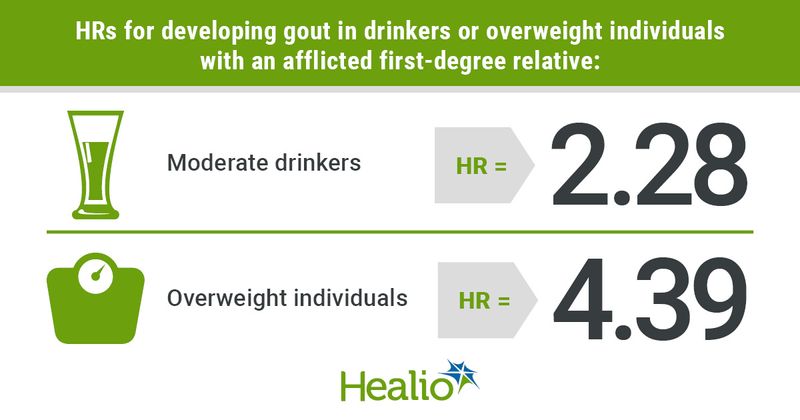Family history paired with obesity or heavy alcohol use ‘markedly’ increase gout risk
Click Here to Manage Email Alerts
Individuals with a family history of gout and who are either obese or heavy alcohol consumers demonstrate a “markedly increased risk” for gout, according to data published in Arthritis Care & Research.
“Given that both genetic and environmental factors contribute to the complex mechanism behind gout pathogenesis, it may be possible that these factors have an interactive relationship, where the presence of obesity or alcohol consumption among individuals with a family history of disease yields a greater or lesser impact compared to non-genetically predisposed persons,” Kyoung-Hoon Kim, PhD, of the Health Insurance Review and Assessment Service, in Wonju, South Korea, and colleagues wrote.

To investigate the contributions of family history and environmental factors to the development of gout, Kim and colleagues analyzed data from the Korean National Health Insurance database and the National Health Screening Program dataset. According to the researchers, these databases feature health information — including BMI and alcohol consumption values — on patients and their family relationships.
For this analysis, patients with BMI values between 25 and 30 were classified as being overweight. Patients were additionally categorized as either non-drinkers, moderate drinkers or heavy drinkers. Men were classified as heavy drinkers if they consumed alcohol two or more times per week, with five or more drinks on any given day. Meanwhile, women were defined as heavy drinkers if they consumed two or more times per week, with four or more drinks on any given day.
Patients with gout were identified via ICD-10 code — M10 as their primary diagnosis — and prescriptions for allopurinol or febuxostat while seeking care at least once within 1 year following diagnosis.
The analysis included a total of 5,524,403 individuals identified between 2002 and 2018. Patients with a first-degree relative impacted by gout demonstrated a 2.42-fold increased risk for developing gout, compared with those without a first-degree family history (95% CI, 2.39-2.46).
Individuals with a family history who were also overweight (HR = 4.39; 95% CI, 4.29-4.49) or moderate alcohol consumers (HR = 2.28; 95% CI, 2.22-2.35) demonstrated a “markedly increased” risk of disease, the researchers wrote. Both of these “exceeded the sum of their individual risks,” the Kim and colleagues wrote. However, this was only statistically significant in patients who were overweight (RERI = 0.96; 95% CI, 0.85-1.06).
Meanwhile, individuals who were obese (RERI = 1.88; 95% CI, 1.61-2.16) or heavy drinkers (RERI = 0.36; 95% CI, 0.2-0.52) experienced a more pronounced interaction vs. those who were overweight or moderate drinkers, according to the researchers.
“Although obesity and alcohol consumption were significantly associated with diseased risk, it appears that a genetic component is the primary driver of familial aggregation,” Kim and colleagues wrote. “Our findings indicate the possibility of a dose-dependent gene-environment interaction, as the combination of both a family history of gout and either high BMI or heavy alcohol consumption was associated with a markedly increased risk of disease, which was even further elevated among obese individuals.”

